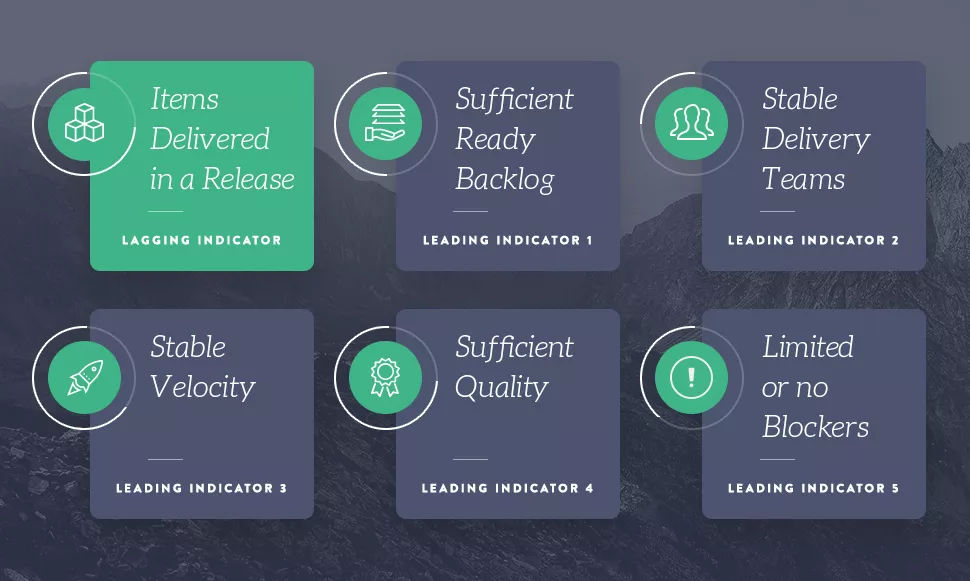Leading and Lagging Indicators
When attempting to attain an objective or key result, people often refer to key performance, leading and lagging indicators. Unfortunately, a lot of people don’t know the difference and how to use them to their benefit. This post should provide some clarity to the differences.
What is a Key Performance Indicator (KPI)
Indicators are statistical values to measure current conditions as well as forecast trends and outcomes. A Key Performance Indicator is a measurable value that demonstrates how effectively a company is achieving key business objectives. Examples of business objectives can range from predictability, early ROI, and innovation, to lower costs, quality, and product fit. In basic analysis, use indicators that quantify current conditions to provide insight into the future. Lagging indicators quantify current conditions. Leading indicators provide insight into the future.
What is a “Lagging Indicator”
Lagging indicators are typically “output” oriented. They are easy to measure but hard to improve or influence. A lagging indicator is one that usually follows an event. The importance of a lagging indicator is its ability to confirm that a pattern is occurring. Here is an example: Many organizations have a goal to deliver some kind of scope on a release date. Items Delivered is a clear lagging indicator that is easy to measure. Go look at a list of items that are done and delivered.
But how do you reach your future release objective of items delivered? For delivering product predictably, there are several “leading” indicators:
What is a “Leading Indicator”
These indicators are easier to influence but hard(er) to measure. I say harder because you have to put processes and tools in place in order to measure them. When you start building product, a lot of what you will understand and build will emerge over time. You don’t know exactly what the level of effort is, until you finish. And if you are like me, given shifting priorities and dependencies, your lagging indicator is a moving target. If you use leading indicators, you can see if you’re tracking in the right direction. You can use the leading indicators to make changes to your behavior or environment while there is still time.
Diminishing ready backlog indicates we have less clarity on upcoming deliverables. An unstable delivery team indicates we don’t have accountability to meet our commitment. Unstable velocity indicates we lack measurable progress that can forecast our completion by the release date.
Examples of Leading Indicators for Product Teams
Now lets imagine you are managing the product development division of your company and your goal is to meet the release commitment you made to your customers.
The outcome is easy to measure: You either finished the items you committed to or not. But how do you influence the outcome? What are the activities you must undertake to achieve the desired outcome?
For example: Make sure there is enough ready backlog that the delivery team does not start working on “unready” work. Make sure your team members are available when needed and not being shared with other teams. Ensure the team is remediating bugs as they go and not waiting until the end of the release to fix them. Look out ahead of the delivery team and mitigate any business, organizational, or technical risks that may delay them.
These can translate into the following “leading” indicators:
- Amount of ready backlog
- Percentage of team availability
- Percentage of deviation of the velocity divided by its mean
- Amount of outstanding bugs
- Number of known blockers
Examples of Leading Indicators for Services Teams
Now let’s imagine your goal is to be compliant with SLA’s (service level agreements) you agreed to with your customers. For instance, the maximum allowed time to resolve critical priority incidents is 48 hours. The outcome (lagging indicator) is easy to measure: You either resolve your incidents in 48 hours or not. Again, ask yourself, how do you influence the outcome? What are the activities to achieve the desired outcome?
For example: Make sure staff start working on incidents immediately when they occur. Make sure that incidents are assigned to the right people with the right skillset and that this person isn’t already overloaded with other work.
These can translate into the following “leading” indicators:
- Percentage of incidents not worked on for 2 hours
- Percentage of open incidents older then 1 day
- Average backlog of incidents per agent
- Percentage of team availability
- Percentage of incidents reopened more then 3 times
Begin measuring these indicators on a daily basis and focus on improving them. If you do, your organization is much more likely to reach its objectives. I have commonly seen organizations treating the leading indicators as the goal and measure of success. This is misguided. The objectives are the lagging indicators, whatever they are. The goal for leading indicators is to improve them over time, to positively impact the lagging indicator.



Comments (3)
Neva Perin
Great post-Derek. Both the lagging and leading indicators are an integral part of a business. When used rightly, they can help enormously. Lagging indicators show the aftermath of what one has done. It provides insight into an organization’s health. But the leading indicators work just on the contrary. They lead forward and helps to anticipate and predict what is going to happen. Combination of both the indicators are absolute requirement can help you spur more than average performance. Ratification of some innovations such as https://www.csat.ai/, MaestroQA, ScorebuddyQA, and Salesforce Einstein into the cartel can be extraordinarily helpful for the future of the business.
David Phillips
sharing your content during an internal SAFe training, bruh!
Seth
What is your distinction or an example of a KPI versus a Key Lagging Indicator?